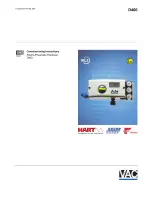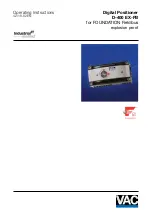
4
If the pilot pressure variation is low, it will be necessary to open the coil to clean the blade and nozzle, repeating the
calibration process. When the pilot pressure variation is satisfactory, simply remove the calibration device and reinsert
the cap screw.
To successfully complete the coil calibration process and fine tune the calibration, we must validate the CWR
measurement during positioner control. So, with the positioner mounted on a small actuator, run the complete
automatic calibration (Full Setup) and set SP = 50% (or any value different from 0% and 100%), waiting for the control
(PV = SP).
Figure 3.4 – Monitoring of CWR with DTM on VVP10 HART.
The CWR value in this condition should preferably be close to 50%, but the limits of 30% and 70% can be used as
acceptable. If it is necessary to decrease the CWR (lower the coil control current), we must turn the screw clockwise,
bringing the blade closer to the nozzle. To increase the CWR (increase the control current of the coil) we must turn the
screw counterclockwise, moving the blade away from the nozzle. For this fine adjustment, the CWR parameter can be
monitored via DTM (Figure 3.4) or by the positioner display itself, in the “CONTROL VALUE” parameter. At the end of
the process, lock the counter nut of the coil screw carefully so that there is no variation in the fine adjustment of the
CWR, performed above.
4
OTHER MAINTENANCES
In addition to regulator and coil calibrations, positioner filter elements
and silencers may require cleaning or replacement over time.
Consider your exchanges in cases of degradation.
In addition, the restriction screw can also be clogged by dirt as it has
a hole of only 0.3 mm.
In this case, the air passage from the regulator to the coil will be
compromised. To remove it, simply unscrew it and remove it with the
help of a pair of needle-nose pliers. After cleaning, for reassembly,
pay attention to the correct positioning of the sealing rings
Figure 4.1 – Other maintenance elements.
Figure 4.2 – Restriction screw with sealing rings.











